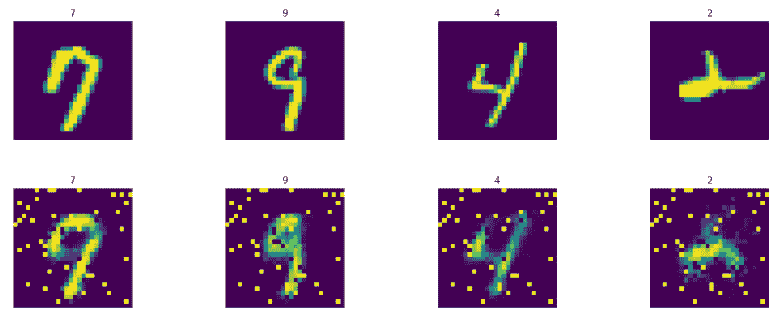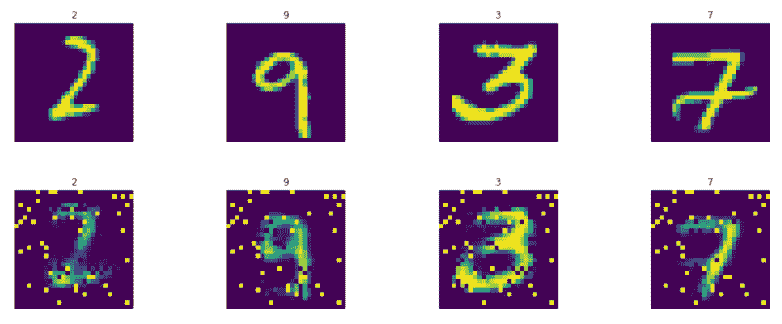# TensorFlow 中的棧式自編碼器
在 TensorFlow 中構建棧式自編碼器模型的步驟如下:
1. 首先,定義超參數如下:
```py
learning_rate = 0.001
n_epochs = 20
batch_size = 100
n_batches = int(mnist.train.num_examples/batch_size)
```
1. 定義輸入(即特征)和輸出(即目標)的數量。輸出數量與輸入數量相同:
```py
# number of pixels in the MNIST image as number of inputs
n_inputs = 784
n_outputs = n_inputs
```
1. 定義輸入和輸出圖像的占位符:
```py
x = tf.placeholder(dtype=tf.float32, name="x", shape=[None, n_inputs])
y = tf.placeholder(dtype=tf.float32, name="y", shape=[None, n_outputs])
```
1. 添加編碼器和解碼器層的神經元數量為`[512,256,256,512]`:
```py
# number of hidden layers
n_layers = 2
# neurons in each hidden layer
n_neurons = [512,256]
# add number of decoder layers:
n_neurons.extend(list(reversed(n_neurons)))
n_layers = n_layers * 2
```
1. 定義`w`和`b`參數:
```py
w=[]
b=[]
for i in range(n_layers):
w.append(tf.Variable(tf.random_normal([n_inputs \
if i==0 else n_neurons[i-1],n_neurons[i]]),
name="w_{0:04d}".format(i)
)
)
b.append(tf.Variable(tf.zeros([n_neurons[i]]),
name="b_{0:04d}".format(i)
)
)
w.append(tf.Variable(tf.random_normal([n_neurons[n_layers-1] \
if n_layers > 0 else n_inputs,n_outputs]),
name="w_out"
)
)
b.append(tf.Variable(tf.zeros([n_outputs]),name="b_out"))
```
1. 構建網絡并為每個層使用 sigmoid 激活函數:
```py
# x is input layer
layer = x
# add hidden layers
for i in range(n_layers):
layer = tf.nn.sigmoid(tf.matmul(layer, w[i]) + b[i])
# add output layer
layer = tf.nn.sigmoid(tf.matmul(layer, w[n_layers]) + b[n_layers])
model = layer
```
1. 使用`mean_squared_error`定義`loss`函數,使用`AdamOptimizer`定義`optimizer`函數:
```py
mse = tf.losses.mean_squared_error
loss = mse(predictions=model, labels=y)
optimizer = tf.train.AdamOptimizer(learning_rate=learning_rate)
optimizer = optimizer.minimize(loss)
```
1. 訓練模型并預測`train`和`test`集的圖像:
```py
with tf.Session() as tfs:
tf.global_variables_initializer().run()
for epoch in range(n_epochs):
epoch_loss = 0.0
for batch in range(n_batches):
X_batch, _ = mnist.train.next_batch(batch_size)
feed_dict={x: X_batch,y: X_batch}
_,batch_loss = tfs.run([optimizer,loss], feed_dict)
epoch_loss += batch_loss
if (epoch%10==9) or (epoch==0):
average_loss = epoch_loss / n_batches
print('epoch: {0:04d} loss = {1:0.6f}'
.format(epoch,average_loss))
# predict images using trained autoencoder model
Y_train_pred = tfs.run(model, feed_dict={x: train_images})
Y_test_pred = tfs.run(model, feed_dict={x: test_images})
```
1. 我們看到以下輸出,因為損失在 20 個周期后顯著減少:
```py
epoch: 0000 loss = 0.156696
epoch: 0009 loss = 0.091367
epoch: 0019 loss = 0.078550
```
1. 現在模型已經過訓練,讓我們顯示訓練模型中的預測圖像。我們寫了一個輔助函數`display_images`來幫助我們顯示圖像:
```py
import random
# Function to display the images and labels
# images should be in NHW or NHWC format
def display_images(images, labels, count=0, one_hot=False):
# if number of images to display is not provided, then display all the images
if (count==0):
count = images.shape[0]
idx_list = random.sample(range(len(labels)),count)
for i in range(count):
plt.subplot(4, 4, i+1)
plt.title(labels[i])
plt.imshow(images[i])
plt.axis('off')
plt.tight_layout()
plt.show()
```
使用此函數,我們首先顯示訓練集中的四個圖像和自編碼器預測的圖像。
第一行表示實際圖像,第二行表示生成的圖像:

生成的圖像有一點點噪音,可以通過更多訓練和超參數調整來消除。現在預測訓練集圖像并不神奇,因為我們在這些圖像上訓練了自編碼器,因此它知道它們。讓我們看一下預測測試集圖像的結果。 第一行表示實際圖像,第二行表示生成的圖像:

哇!經過訓練的自編碼器能夠生成相同的數字,只有從 768 中學到的 256 個特征。生成的圖像中的噪聲可以通過超參數調整和更多訓練來改善。
- TensorFlow 101
- 什么是 TensorFlow?
- TensorFlow 核心
- 代碼預熱 - Hello TensorFlow
- 張量
- 常量
- 操作
- 占位符
- 從 Python 對象創建張量
- 變量
- 從庫函數生成的張量
- 使用相同的值填充張量元素
- 用序列填充張量元素
- 使用隨機分布填充張量元素
- 使用tf.get_variable()獲取變量
- 數據流圖或計算圖
- 執行順序和延遲加載
- 跨計算設備執行圖 - CPU 和 GPU
- 將圖節點放置在特定的計算設備上
- 簡單放置
- 動態展示位置
- 軟放置
- GPU 內存處理
- 多個圖
- TensorBoard
- TensorBoard 最小的例子
- TensorBoard 詳情
- 總結
- TensorFlow 的高級庫
- TF Estimator - 以前的 TF 學習
- TF Slim
- TFLearn
- 創建 TFLearn 層
- TFLearn 核心層
- TFLearn 卷積層
- TFLearn 循環層
- TFLearn 正則化層
- TFLearn 嵌入層
- TFLearn 合并層
- TFLearn 估計層
- 創建 TFLearn 模型
- TFLearn 模型的類型
- 訓練 TFLearn 模型
- 使用 TFLearn 模型
- PrettyTensor
- Sonnet
- 總結
- Keras 101
- 安裝 Keras
- Keras 中的神經網絡模型
- 在 Keras 建立模型的工作流程
- 創建 Keras 模型
- 用于創建 Keras 模型的順序 API
- 用于創建 Keras 模型的函數式 API
- Keras 層
- Keras 核心層
- Keras 卷積層
- Keras 池化層
- Keras 本地連接層
- Keras 循環層
- Keras 嵌入層
- Keras 合并層
- Keras 高級激活層
- Keras 正則化層
- Keras 噪音層
- 將層添加到 Keras 模型
- 用于將層添加到 Keras 模型的順序 API
- 用于向 Keras 模型添加層的函數式 API
- 編譯 Keras 模型
- 訓練 Keras 模型
- 使用 Keras 模型進行預測
- Keras 的附加模塊
- MNIST 數據集的 Keras 序列模型示例
- 總結
- 使用 TensorFlow 進行經典機器學習
- 簡單的線性回歸
- 數據準備
- 構建一個簡單的回歸模型
- 定義輸入,參數和其他變量
- 定義模型
- 定義損失函數
- 定義優化器函數
- 訓練模型
- 使用訓練的模型進行預測
- 多元回歸
- 正則化回歸
- 套索正則化
- 嶺正則化
- ElasticNet 正則化
- 使用邏輯回歸進行分類
- 二分類的邏輯回歸
- 多類分類的邏輯回歸
- 二分類
- 多類分類
- 總結
- 使用 TensorFlow 和 Keras 的神經網絡和 MLP
- 感知機
- 多層感知機
- 用于圖像分類的 MLP
- 用于 MNIST 分類的基于 TensorFlow 的 MLP
- 用于 MNIST 分類的基于 Keras 的 MLP
- 用于 MNIST 分類的基于 TFLearn 的 MLP
- 使用 TensorFlow,Keras 和 TFLearn 的 MLP 總結
- 用于時間序列回歸的 MLP
- 總結
- 使用 TensorFlow 和 Keras 的 RNN
- 簡單循環神經網絡
- RNN 變種
- LSTM 網絡
- GRU 網絡
- TensorFlow RNN
- TensorFlow RNN 單元類
- TensorFlow RNN 模型構建類
- TensorFlow RNN 單元包裝器類
- 適用于 RNN 的 Keras
- RNN 的應用領域
- 用于 MNIST 數據的 Keras 中的 RNN
- 總結
- 使用 TensorFlow 和 Keras 的時間序列數據的 RNN
- 航空公司乘客數據集
- 加載 airpass 數據集
- 可視化 airpass 數據集
- 使用 TensorFlow RNN 模型預處理數據集
- TensorFlow 中的簡單 RNN
- TensorFlow 中的 LSTM
- TensorFlow 中的 GRU
- 使用 Keras RNN 模型預處理數據集
- 使用 Keras 的簡單 RNN
- 使用 Keras 的 LSTM
- 使用 Keras 的 GRU
- 總結
- 使用 TensorFlow 和 Keras 的文本數據的 RNN
- 詞向量表示
- 為 word2vec 模型準備數據
- 加載和準備 PTB 數據集
- 加載和準備 text8 數據集
- 準備小驗證集
- 使用 TensorFlow 的 skip-gram 模型
- 使用 t-SNE 可視化單詞嵌入
- keras 的 skip-gram 模型
- 使用 TensorFlow 和 Keras 中的 RNN 模型生成文本
- TensorFlow 中的 LSTM 文本生成
- Keras 中的 LSTM 文本生成
- 總結
- 使用 TensorFlow 和 Keras 的 CNN
- 理解卷積
- 了解池化
- CNN 架構模式 - LeNet
- 用于 MNIST 數據的 LeNet
- 使用 TensorFlow 的用于 MNIST 的 LeNet CNN
- 使用 Keras 的用于 MNIST 的 LeNet CNN
- 用于 CIFAR10 數據的 LeNet
- 使用 TensorFlow 的用于 CIFAR10 的 ConvNets
- 使用 Keras 的用于 CIFAR10 的 ConvNets
- 總結
- 使用 TensorFlow 和 Keras 的自編碼器
- 自編碼器類型
- TensorFlow 中的棧式自編碼器
- Keras 中的棧式自編碼器
- TensorFlow 中的去噪自編碼器
- Keras 中的去噪自編碼器
- TensorFlow 中的變分自編碼器
- Keras 中的變分自編碼器
- 總結
- TF 服務:生產中的 TensorFlow 模型
- 在 TensorFlow 中保存和恢復模型
- 使用保護程序類保存和恢復所有圖變量
- 使用保護程序類保存和恢復所選變量
- 保存和恢復 Keras 模型
- TensorFlow 服務
- 安裝 TF 服務
- 保存 TF 服務的模型
- 提供 TF 服務模型
- 在 Docker 容器中提供 TF 服務
- 安裝 Docker
- 為 TF 服務構建 Docker 鏡像
- 在 Docker 容器中提供模型
- Kubernetes 中的 TensorFlow 服務
- 安裝 Kubernetes
- 將 Docker 鏡像上傳到 dockerhub
- 在 Kubernetes 部署
- 總結
- 遷移學習和預訓練模型
- ImageNet 數據集
- 再訓練或微調模型
- COCO 動物數據集和預處理圖像
- TensorFlow 中的 VGG16
- 使用 TensorFlow 中預訓練的 VGG16 進行圖像分類
- TensorFlow 中的圖像預處理,用于預訓練的 VGG16
- 使用 TensorFlow 中的再訓練的 VGG16 進行圖像分類
- Keras 的 VGG16
- 使用 Keras 中預訓練的 VGG16 進行圖像分類
- 使用 Keras 中再訓練的 VGG16 進行圖像分類
- TensorFlow 中的 Inception v3
- 使用 TensorFlow 中的 Inception v3 進行圖像分類
- 使用 TensorFlow 中的再訓練的 Inception v3 進行圖像分類
- 總結
- 深度強化學習
- OpenAI Gym 101
- 將簡單的策略應用于 cartpole 游戲
- 強化學習 101
- Q 函數(在模型不可用時學習優化)
- RL 算法的探索與開發
- V 函數(模型可用時學習優化)
- 強化學習技巧
- 強化學習的樸素神經網絡策略
- 實現 Q-Learning
- Q-Learning 的初始化和離散化
- 使用 Q-Table 進行 Q-Learning
- Q-Network 或深 Q 網絡(DQN)的 Q-Learning
- 總結
- 生成性對抗網絡
- 生成性對抗網絡 101
- 建立和訓練 GAN 的最佳實踐
- 使用 TensorFlow 的簡單的 GAN
- 使用 Keras 的簡單的 GAN
- 使用 TensorFlow 和 Keras 的深度卷積 GAN
- 總結
- 使用 TensorFlow 集群的分布式模型
- 分布式執行策略
- TensorFlow 集群
- 定義集群規范
- 創建服務器實例
- 定義服務器和設備之間的參數和操作
- 定義并訓練圖以進行異步更新
- 定義并訓練圖以進行同步更新
- 總結
- 移動和嵌入式平臺上的 TensorFlow 模型
- 移動平臺上的 TensorFlow
- Android 應用中的 TF Mobile
- Android 上的 TF Mobile 演示
- iOS 應用中的 TF Mobile
- iOS 上的 TF Mobile 演示
- TensorFlow Lite
- Android 上的 TF Lite 演示
- iOS 上的 TF Lite 演示
- 總結
- R 中的 TensorFlow 和 Keras
- 在 R 中安裝 TensorFlow 和 Keras 軟件包
- R 中的 TF 核心 API
- R 中的 TF 估計器 API
- R 中的 Keras API
- R 中的 TensorBoard
- R 中的 tfruns 包
- 總結
- 調試 TensorFlow 模型
- 使用tf.Session.run()獲取張量值
- 使用tf.Print()打印張量值
- 用tf.Assert()斷言條件
- 使用 TensorFlow 調試器(tfdbg)進行調試
- 總結
- 張量處理單元
